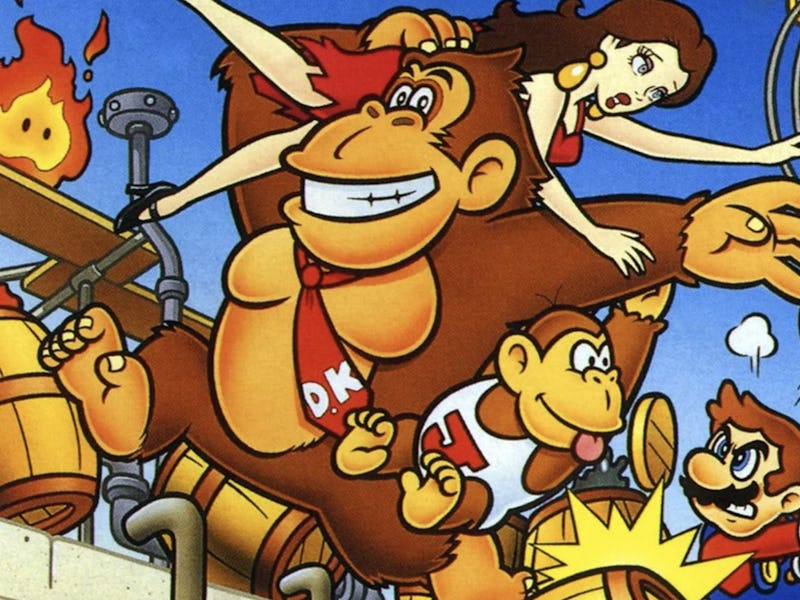The Forgotten Nintendo Masterpiece That Changed Mario Forever
1994 brought a brand new Mario to Game Boy.

You need hindsight to track evolution. In biology, it's all about poring over fossil records and DNA analysis to discover how yesterday’s T-rex became today’s chicken. In gaming, it means revisiting now-defunct platforms in search of hidden gems and hints about a franchise’s future. Nintendo is one of the easiest to track thanks to its deep bench, familiar faces, and longstanding ability to deliver innovative, joyful games. Its beloved mascot Mario has undergone a slew of changes since his first appearance in 1981’s Donkey Kong. So perhaps it's appropriate that the modern Mario we know and love got his start in a Donkey Kong game, too.
According to legendary Nintendo producer Shigeru Miyamoto, Donkey Kong ‘94 was conceived as a 10th anniversary project for the franchise. Unfortunately, the timing didn’t quite work out and Nintendo missed the 1981 release window by a few years, ultimately debuting the game on June 14, 1994 in Japan (and a month later in America). The extra attention was worth it. If you’ve never played it, Donkey Kong ‘94 might seem to be a simple collection of arcade-style stages. It’s not. It’s one of the most meta and innovative titles Nintendo ever produced.
Donkey Kong ‘94 starts out with a deception. The first four stages are slightly modified versions of original Donkey Kong arcade stages. This wasn’t done to fool players or throw them off the scent of what the game was actually going to be, but rather as an homage. Miyamoto and his team assumed anyone who purchased the game did so out of nostalgia and thus should be rewarded with a few of the stages they were likely expecting.
What players weren’t expecting, however, was a bold new moveset for Mario. For the first time in his career, the mustachioed plumber could perform a triple jump and a backflip. These moves didn't resurface until Mario 64 and were, understandably, a revelation for players at that time. Many thought Mario had never done these things before, but they were wrong. He did them in Donkey Kong 94, and they allow players to get through those opening vintage levels in mere seconds. If that seems too easy, don’t worry, there were plenty of other surprises in store.
These early arcade-style levels were merely subterfuge.
Once players breeze through the first four stages of Donkey Kong ‘94, the actual game reveals itself. In one of the best bait-and-switch moments in gaming history, there are 100 levels of puzzle platforming mayhem awaiting players after they finish the arcade levels. Remember, this is 1994. There’s no internet, no forums, no way of knowing outside of a Nintendo Power subscription or neighborhood folklore that Donkey Kong 94 is wayyyyy more than it appears.
Once players finish the first four stages, it seems like they’ve won. Mario defeated Donkey Kong and a big floating heart appears as Paulina and Mario seem destined for a happy ending. Then, suddenly, Donkey Kong recovers and smashes the whole level. Mario is knocked out and Donkey Kong rushes off screen with Paulina. When players chase him, they don’t go to another stage. Instead, a short scene shows Donkey Kong escaping into a locked fortress. A key appears and Mario carries it over and unlocks the door. Then, the reveal: There isn’t a stage on the other side but an entire game map. Big City, world 1-1. Let’s rock.
World maps? In this economy??
The gameplay is sublime. It’s not an exaggeration to say that some of the best minds at Nintendo (and gaming in general) worked on this title. In an interview included in the game’s official strategy guide, Miyamoto said the philosophy behind the game design was that “above all else, I think it's especially important that simply moving the character with the controller is fun.” This is why Mario’s moveset is available right from the start, to encourage players to have fun as they experiment and learn more about the game.
Learning is also central to the level design. This isn’t your grandparent’s Donkey Kong. It is a dynamic puzzle platformer in every sense of the word. Anyone familiar with Super Mario 2 remembers hauling those giant keys around, and those same keys are the centerpiece for most levels. The goal is to transport the key to the goal without dropping it for more than a few seconds, or else it disappears. Easier said than done, as players trial-and-error their way to the safest path through each stage.
Mario’s legacy aside, Donkey Kong ‘94 is a masterpiece because it does everything right. The new Mario moves and meta plot twist get a lot of attention, but the pace of the gameplay, incredible soundtrack, and massive amount of variety across each game world are all best-in-class. It holds up incredibly well today, but you won’t find it on Switch Online (yet). Here’s hoping Nintendo remembers this forgotten masterpiece soon so everyone can experience a landmark piece of gaming history.